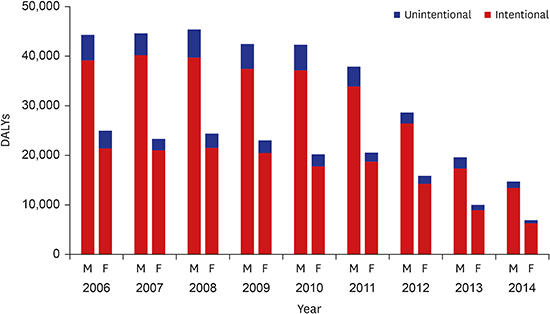1. Bertolote JM, Fleischmann A, Eddleston M, Gunnell D. Deaths from pesticide poisoning: a global response. Br J Psychiatry. 2006; 189(3):201–203.
2. Gunnell D, Eddleston M, Phillips MR, Konradsen F. The global distribution of fatal pesticide self-poisoning: systematic review. BMC Public Health. 2007; 7(357):357.

3. Prüss-Üstün A, Corvalán C. Preventing Disease through Healthy Environments. Towards an Estimate of the Environmental Burden of Disease. Geneva: World Health Organization;2006.
4. Cha ES, Khang YH, Lee WJ. Mortality from and incidence of pesticide poisoning in South Korea: findings from National Death and Health Utilization Data between 2006 and 2010. PLoS One. 2014; 9(4):e95299.

5. Kim HJ, Cha ES, Ko Y, Kim J, Kim SD, Lee WJ. Pesticide poisonings in South Korea: findings from the National Hospital Discharge Survey 2004–2006. Hum Exp Toxicol. 2012; 31(8):751–758.
6. Ko Y, Kim HJ, Cha ES, Kim J, Lee WJ. Emergency department visits due to pesticide poisoning in South Korea, 2006–2009. Clin Toxicol (Phila). 2012; 50(2):114–119.

7. Lee WJ, Cha ES, Park J, Ko Y, Kim HJ, Kim J. Incidence of acute occupational pesticide poisoning among male farmers in South Korea. Am J Ind Med. 2012; 55(9):799–807.

8. Cha ES, Chang SS, Gunnell D, Eddleston M, Khang YH, Lee WJ. Impact of paraquat regulation on suicide in South Korea. Int J Epidemiol. 2016; 45(2):470–479.

9. Murray C, Lopez AD. Rethinking DALYs. The Global Burden of Disease, A Comprehensive Assessment of Mortality and Disability from Diseases, Injuries, and Risk Factors in 1990 and Projected to 2020. Cambridge: Harvard University Press;1996. p. 1–98.
10. World Health Organization. WHO Methods and Data Sources for Global Burden of Disease Estimates 2000-2011. Global Health Estimates Technical Paper. Geneva: WHO/HIS/HSI/GHE;2013.
11. GBD 2013 DALYs and HALE Collaborators, Murray CJ, Barber RM, Foreman KJ, Abbasoglu Ozgoren A, Abd-Allah F, et al. Global, regional, and national disability-adjusted life years (DALYs) for 306 diseases and injuries and healthy life expectancy (HALE) for 188 countries, 1990–2013: quantifying the epidemiological transition. Lancet. 2015; 386(10009):2145–2191.
12. World Health Organization. International Statistical Classification of Diseases and Related Health Problems. 10th revision. Geneva: World Health Organization;1992.
13. Ahmad OB, Boschi-Pinto C, Lopez AD, Murray CJ, Lozano R, Inoue M. Age Standardization of Rates: a New WHO Standard. GPE Discussion Paper Series: No. 31. EIP/GPE/EBD. Geneva: World Health Organization;2001.
14. Salomon JA, Haagsma JA, Davis A, de Noordhout CM, Polinder S, Havelaar AH, et al. Disability weights for the Global Burden of Disease 2013 study. Lancet Glob Health. 2015; 3(11):e712–e723.

15. Ock M, Lee JY, Oh IH, Park H, Yoon SJ, Jo MW. Disability weights measurement for 228 causes of disease in the Korean burden of disease study 2012. J Korean Med Sci. 2016; 31:Suppl 2. S129–S138.

17. Haagsma JA, Graetz N, Bolliger I, Naghavi M, Higashi H, Mullany EC, et al. The global burden of injury: incidence, mortality, disability-adjusted life years and time trends from the Global Burden of Disease study 2013. Inj Prev. 2016; 22(1):3–18.
18. Law CK, Yip PS, Huo Y. Assessing the quantitative impact of suicide on life expectancy in Hong Kong: 1986–2006. Arch Suicide Res. 2010; 14(3):284–290.

19. Law CK, Yip PS, Chen YY. The economic and potential years of life lost from suicide in Taiwan, 1997–2007. Crisis. 2011; 32(3):152–159.

20. Gunnell D, Middleton N. National suicide rates as an indicator of the effect of suicide on premature mortality. Lancet. 2003; 362(9388):961–962.

21. Lee JW, Hwang IW, Kim JW, Moon HJ, Kim KH, Park S, et al. Common pesticides used in suicide attempts following the 2012 paraquat ban in Korea. J Korean Med Sci. 2015; 30(10):1517–1521.

22. Lee WJ, Ko Y, Cha ES. Acute pesticide poisoning among children in South Korea: findings from National Health Insurance claims data, 2006–2009. J Trop Pediatr. 2014; 60(1):4–9.

23. Kim KS, Kim SD, Lee SH. Trend of mortality rate and injury burden of transport accidents, suicides, and falls. J Prev Med Public Health. 2012; 45(1):8–13.

24. Veerman JL, Sacks G, Antonopoulos N, Martin J. The impact of a tax on sugar-sweetened beverages on health and health care costs: a modelling study. PLoS One. 2016; 11(4):e0151460.

25. Chan CH, Caine ED, Chang SS, Lee WJ, Cha ES, Yip PS. The impact of improving suicide death classification in South Korea: a comparison with Japan and Hong Kong. PLoS One. 2015; 10(5):e0125730.

26. Cha ES, Chang SS, Lee WJ. Potential underestimation of pesticide suicide and its impact on secular trends in South Korea, 1991–2012. Inj Prev. 2016; 22(3):189–194.

27. Nord E. Uncertainties about disability weights for the Global Burden of Disease study. Lancet Glob Health. 2015; 3(11):e661–2.











 PDF
PDF Citation
Citation Print
Print




 XML Download
XML Download